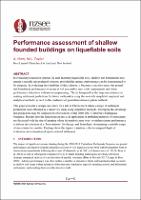Performance assessment of shallow founded buildings on liquefiable soils
Abstract
In evaluating foundation options for sites featuring liquefiable soils, shallow raft foundations may remain a suitable and preferred solution, provided the seismic performance can be demonstrated to be adequate. In evaluating the feasibility of this solution, it becomes critical to assess the ground and foundation performance to ensure it will reasonably meet code requirements and client performance objectives without overengineering. This is hampered by the large uncertainties in making settlement predictions for future earthquakes using the available simplified empirical and analytical methods, as well as the crudeness of geotechnical investigation methods.
This paper presents a design case study for a site in Christchurch where a range of settlement predictions were obtained in a sensitivity study using simplified methods, leveraging the advantage that predictions may be compared to observations of the 2010-2011 Canterbury Earthquake Sequence. Insights into the limitations in practical application of published methods of assessment are discussed with the aim of gauging where the methods may over- or underestimate performance to inform the selection of a ‘best estimate’ for design, and from there, determining a suitable range of uncertainty to consider. Findings show the highest variation is due to assigned depth of evaluation and estimation of ejecta-induced settlement.

